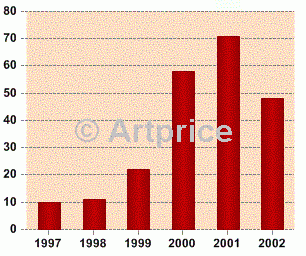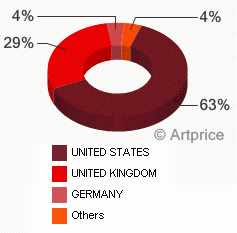Thomas Ruff (1958)
[06.05.2003]
Thomas Ruff is, with Andreas Gursky and Thomas Struth, one of the stars of German contemporary photography. He had his first success at auction in the late 1990s. But after the boom of 2001, the market for his work seems to have subsided.
Thomas Ruff was born in the south German town of Zell am Harmersbach in 1958. He studied under Bernd and Hilla Becher in 1977-85 and lives and works in Düsseldorf. In the mid 1980s, he pioneered the use of very large format photographs for his portraits. He has been constantly renewing his work ever since, working through a succession of themes including architecture, outer space, photomontages, 3D images and pornographic themes. US art galleries were quick to take him up — his portraits were first exhibited at the Fraenkel Gallery in San Francisco in 1986 — and in the late 1980s his works appeared at the Cologne Art Fair. In 1988 he represented Germany at the 43rd Venice Biennale. Like his contemporaries, Thomas Demand, Thomas Struth and Andreas Gursky, he was soon being honoured by the best galleries, feted as a top talent and given space in all the big contemporary art events. In 2002, his work appeared at The Armory Show, the FIAC, Art 33 Basel, Art Basel Miami Beach, Art Forum Berlin, ArtBrussels. He dedicated the year to a large travelling exhibition entitled “Thomas Ruff – Photographs 1979 to the Present”. After a short spell at the Museum of Contemporary Art in Porto, the exhibition will move to the Tate Liverpool from 9 May-6 July 2003. The general acclaim for Ruff is reflected at auction. His works are fetching unprecedented prices and to keep prices on the boil he generally makes fewer than 10 prints of a work.
Artworks at auctions
In 2002, 44 Thomas Ruff photographs came up for auction. The artist made his début at Christie’s in 1991 with House N.R.71, a 230 x 180 cm photograph estimated at USD 10,000-12,000 that could only find a buyer at USD 7,000. And still today the only prints from his House series that really sell well are the very large format prints of over two metres. Small prints below 30 cm estimated at below USD 1,000 are harder to sell. It took time for investors’ preferences to become clear given the rich variety of works available but trends now seem set. His Constellation series is one of the most sought after. Until the mid-1990s these prints were making USD 10,000. Bidding now starts at around USD 100,000. Constellation prints which were in abundant supply two years ago are becoming ever scarcer at auction. The large format portraits are making between USD 10,000-25,000. Buyers with less deep pockets can still auctions packed with small prints going for less than EUR 2,000 a piece. Such works accounts for almost 40% of all Thomas Struth photographs sold but note that buyers are more selective with these smaller prints.
The market places
The lower priced prints are most commonly found in German auction houses such as Lempertz, Hauswedell & Nolte, Germann, Carola Van Ham and Nagel. Germany has 20% of the market for prints, making it second only to the US specialist market in the very expensive and very large formats. New York knocked down 63% of Ruff’s turnover on only 37% of his lots sold in 1999-2002. Ruff prints also come up at most sales in major European auction houses in London, Paris, Amsterdam and Stockholm.
Buy or sell
The record price paid at auction was for “Stern 02h56 –65°” a very large format colour print from his 1989 Constellation series printed in two copies, which Christie’s London knocked down for GBP 70,000 (USD 102,000) on 23 October 2001. At the time, like Gursky and Struth, German photographers working in the tradition of Bernd & Hilla Becher were seeing their prices shoot up. In 1997-2001 Ruff’s price index rocketed 256%. Seeing this price increase, collectors were eager to speculate by selling off works acquired a few years previously, so supply has increased. In 1997 only 10 prints were auctioned compared with 122 in 2001. So many works on offer has taken the edge off the bidding on the floor. After shooting up, prices stabilised and then in 2002 even fell by 4%.The receding tide of euphoria left the auction houses looking slightly overambitious in their estimates and buy-ins rose in 2002, to over 46% in 2002 compared to just 9% in 1999. Faced with an abundant and varied output, investors must inevitably be cautious over their choice of theme and edition. The signature aside, the market is likely to become increasingly selective. Remember the artist is only 45 and may yet surprise with some fine work.
Thomas RuffArtprice Indexall media categories, base January 1997 = 100, currency: EUR  Thomas Ruff Number of lots sold
Thomas Ruff Number of lots sold  Thomas Ruff Auction sales turnover 1999-2002 / weight by country
Thomas Ruff Auction sales turnover 1999-2002 / weight by country  © Artprice
© Artprice




 0
0
